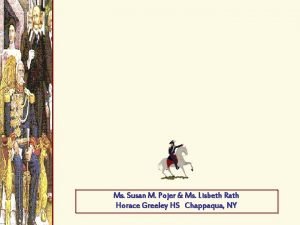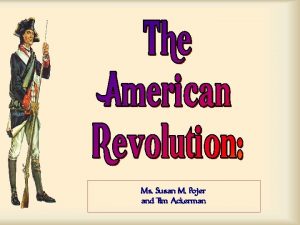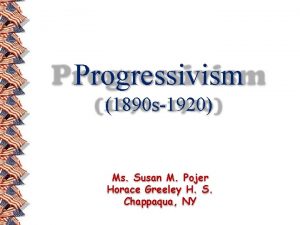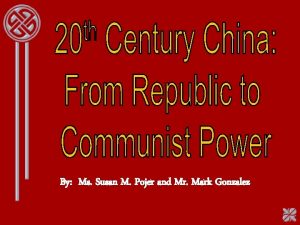Original Source Susan Pojer and Philip Deak Standard




















![New Agricultural Technology Steel Plow [“Sod Buster”] “Prairie Fan” Water Pump Mechanized reaper Barbed New Agricultural Technology Steel Plow [“Sod Buster”] “Prairie Fan” Water Pump Mechanized reaper Barbed](https://slidetodoc.com/presentation_image_h2/f5943295b6e85ad0375d71d7c0290ca0/image-21.jpg)










- Slides: 31

Original Source: Susan Pojer and Philip Deak Standard 4

Key Tensions Native Americans Ethnic Minorities Environmentalists Lawlessness of the Frontier Buffalo Hunters Railroads U. S. Government Nativists Big Business Interests [mining, timber] Local Govt. Officials Farmers Buffalo Hunters “Civilizing” Forces

Homestead Act • Congress passed the Homestead act offering 160 acres of land to any citizen willing to move out West • RR and private spectators took advantage of the Act. • Only 10% of the land actually went where it was intended to go.

Frontier Settlements: 1870 -1890

Black “Exoduster” Homesteaders

Black Cowboys

Railroad Construction The East and the West were linked!!

Native Americans vs. Railroads • While the transcontinental railroad linked the national market, it destroyed the lives of Native Americans. • Buffalo were seen as a hazard to the railroads. • Settlers were encouraged to kill the buffalo which the Plain Indians depended on, thus decimating the Indians’ way of life. • As white settlers moved West following the railroads, Native Americans were pushed from their native lands to reservations.

Destruction of the Buffalo Herds The near extinction of the buffalo.

Reservation Policyinstead of a block of land, created specific boundaries for tribes

Native American Reservations • Similar to the Indian Removal act of 1830 and the Trail of tears, native Americans were forced off their traditional lands and moved to reservations. • They were forced onto smaller reservations and taken advantage of by corrupt governments. • Some tried to resist but the US cavalry put down their resistance in the Indian wars.

Dawes Severalty Act : Assimilation Policy make the Native Americans more “American” Native American reservations, assimilation and land

Battle of Wounded Knee • On Dec. 28, 1890, the US cavalry rounded up 350 starving and freezing Sioux and took them to camp at Wounded Knee, in South Dakota. • Demanded Indians give up all weapons. • Shots were fired and within minutes 300 unarmed Native Americans including children were killed. • This brought the Indian wars and the era of Indian resistance to an end.

Indian Reservations Today

Railroad Effect • A National Network – 1859, railroads extend west of Missouri River – 1869, first transcontinental railroad completed, spans the nation • New Towns and Markets – Railroads require great supply of materials, parts – Iron, coal, steel, lumber, glass industries grow to meet demand – Railroads link isolated towns, promote trade, interdependence – Nationwide network of suppliers, markets develops – Towns specialize, sell large quantities of their product nationally – New towns grow along railroad lines

Railroad Expansion

Railroads changed American life in many ways: • • Travel took less time. Mail arrived faster. Railroads brought new jobs. Local stores profited from train traffic. Sales were not limited to local markets. Unfamiliar items appeared locally. Railroads moved settlers to new locations. • Railroads tied the nation together. • Transportation charges decreased

Problems of the Railroad Era • Too many railroads were built. – Over-expansion frequently ended in bankruptcies. – Failures spread economic disaster to workers, businesses, and farmers. – Railroads resorted to discriminatory practices

Problems of the Railroad Era • Railroad Abuses – Farmers angry over perceived railroad corruption • railroads sell government lands to businesses, not settlers • fix prices, keep farmers in debt • charge different customers different rates • Crédit Mobilier – Wish for control, profit leads some railroad magnates to corruption – Union Pacific stockholders form construction company, Crédit Mobilier – overpay for laying track, pocket profits

Farmers and the Populist Movement
![New Agricultural Technology Steel Plow Sod Buster Prairie Fan Water Pump Mechanized reaper Barbed New Agricultural Technology Steel Plow [“Sod Buster”] “Prairie Fan” Water Pump Mechanized reaper Barbed](https://slidetodoc.com/presentation_image_h2/f5943295b6e85ad0375d71d7c0290ca0/image-21.jpg)
New Agricultural Technology Steel Plow [“Sod Buster”] “Prairie Fan” Water Pump Mechanized reaper Barbed Wire created by Joseph Glidden

Farmers face economic crisis • In the late 19 th century, farmers struggled to survive. – Between 1867 and 1887 the price of a bushel of wheat fell from two dollars to 68 cents – railroads conspired to keep transportation costs artificially high – farmers were caught in a cycle of debt

Farmers face economic crisis • Farmers produce an abundance of crops even though population has been increasing – supply exceeds demand prices drop – unable to make payments on loans – Farmers attempt to grow more – railroad raised the price of transporting goods


The Grange • Originally a social organization designed to alleviate the isolation of farm life economic and political organization • Grangers sponsor state, local political candidates • Because farmers blamed the RR for their high transportation cost, state legislatures passed laws to protect the farmer • Granger Laws – Tried to regulate the rates charged by railroads – Munn v. Illinois-Supreme Court upholds states’ right to regulate RR

Interstate Commerce Act • 1886, Supreme Court: states cannot set rates on interstate commerce • This sets a precedent for the regulation of business by the federal government • Public outrage leads to Interstate Commerce Act of 1887 – federal government can supervise railroads – establishes Interstate Commerce Commission (ICC) • Yet, with a series of Supreme Court cases the effectiveness of the law is limited

Farmer’s Alliance • Out the Granger movement, the Farmer’s Alliance was formed • African American farmers were also active in the Alliance movement. • This activity contributed to the movement to formalize segregation in Jim Crow laws. • Elite southerners and Northern capitalists feared the cooperation of African American and white farmers, thus they used race to divide them. • The Farmer’s alliance realized they would need more political power to be effective.

Populist Party • In 1892, Alliance members helped found the Populist Party, which drew support from urban laborers as well as farmers. • Populist economic reforms included: – An increase in the supply of money – A rise in crop prices – Lower taxes – A federal loan program – An 8 -hour workday – Reduced immigration

Populist political reforms • • • Direct election of senators Single term presidencies Secret ballots graduated income tax system of federal farm loans • 8 hour work day • restrictions on immigrations • Bimetallism


Bryan’s “Cross of Gold” Speech • The Democrats hoped that free silver would increase the supply of money and provide more credit to farmers and workers. But despite Bryan’s stirring words, “You shall not crucify mankind upon a cross of gold, ” Mc. Kinley won the 1896 election.
 Susan pojer
Susan pojer Tim ackerman
Tim ackerman Susan pojer
Susan pojer Susan pojer
Susan pojer Susan pojer
Susan pojer Susan pojer
Susan pojer Susan pojer
Susan pojer Susan pojer
Susan pojer Susan pojer
Susan pojer Susan pojer
Susan pojer Susan pojer
Susan pojer Deák ferenc iskola
Deák ferenc iskola Thomas von deak
Thomas von deak Roman deak
Roman deak The original source of all genetic variation is
The original source of all genetic variation is Original source
Original source Differential diagnosis for atopic dermatitis
Differential diagnosis for atopic dermatitis Original source
Original source Mirko pojer
Mirko pojer Mirko pojer
Mirko pojer Presinkopa
Presinkopa Mirko pojer
Mirko pojer Mirko pojer
Mirko pojer The standard error of the mean
The standard error of the mean Standard language vs home language
Standard language vs home language Objective of standard costing
Objective of standard costing Bahagian pembangunan kurikulum dskp
Bahagian pembangunan kurikulum dskp Electric circuits nilsson
Electric circuits nilsson Trifles quiz answers
Trifles quiz answers Susan bordo the body and the reproduction of femininity
Susan bordo the body and the reproduction of femininity Prolog romeo and juliet
Prolog romeo and juliet Cranach adam and eve
Cranach adam and eve





















































